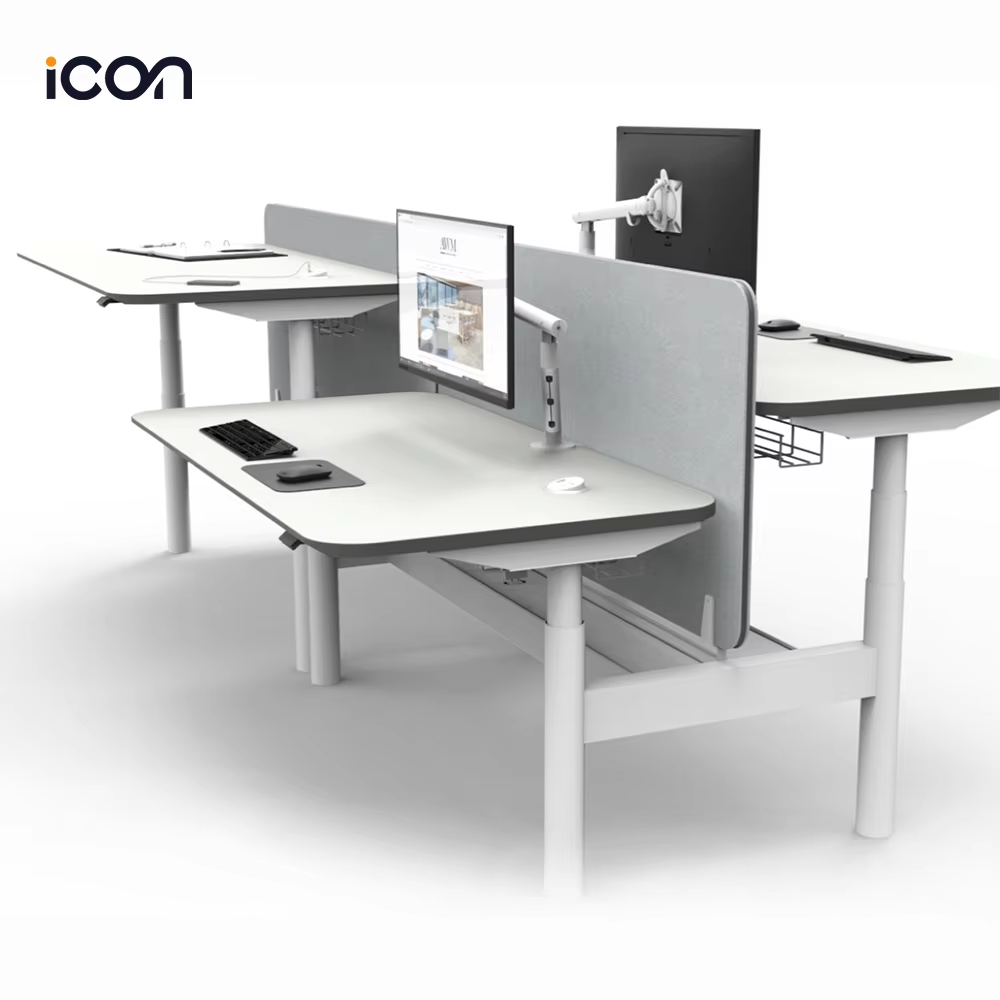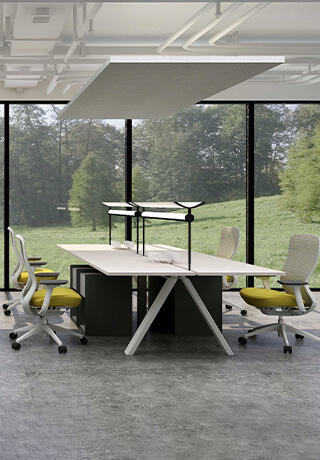The choice of materials in office furniture construction has evolved dramatically over the past decade, with manufacturers increasingly focusing on durability, sustainability, and aesthetic appeal. Modern workplace environments demand furniture solutions that can withstand daily use while maintaining their appearance and structural integrity. When selecting office desks for commercial or home environments, understanding the material composition becomes crucial for making informed purchasing decisions that will provide long-term value and performance.
The foundation of any quality office desk lies in its material selection, which directly impacts the furniture's lifespan, maintenance requirements, and overall user experience. Professional environments require desks that can endure constant use, support varying weights, and resist wear from electronic equipment, writing materials, and daily activities. The evolution of manufacturing technologies has introduced innovative materials and construction methods that enhance desk durability while reducing environmental impact.
Steel Framework Components
Carbon Steel Construction Benefits
Carbon steel represents one of the most reliable materials for desk framework construction, offering exceptional strength-to-weight ratios and long-term durability. This material provides excellent structural support for heavy desktop surfaces and equipment while maintaining dimensional stability under varying load conditions. Carbon steel frames undergo specialized coating processes to prevent corrosion and extend operational life, making them ideal for high-use office environments.
The manufacturing process for carbon steel desk components involves precise engineering to optimize material thickness and joint construction. Advanced welding techniques ensure seamless connections between frame members, eliminating weak points that could compromise structural integrity. Quality carbon steel frameworks can support substantial weight loads while maintaining smooth operation of mechanical components such as height adjustment mechanisms.
Powder Coating Protection Systems
Powder coating technology has revolutionized the protection and appearance of steel desk frameworks, providing superior durability compared to traditional paint finishes. This electrostatically applied coating creates a uniform, chip-resistant surface that withstands daily wear while maintaining color consistency over extended periods. The curing process bonds the coating material directly to the steel substrate, creating an integrated protective barrier against moisture, scratches, and chemical exposure.
Modern powder coating formulations incorporate anti-microbial properties and enhanced UV resistance, ensuring that desk frameworks maintain their appearance and hygienic properties in various lighting conditions. The application process allows for precise color matching and texture variations, enabling manufacturers to offer diverse aesthetic options without compromising protective performance. This coating system significantly extends the service life of steel components while reducing maintenance requirements.
Desktop Surface Materials
Engineered Wood Products
High-density particleboard and medium-density fiberboard represent cornerstone materials in modern desk construction, offering consistent performance characteristics and excellent surface preparation properties. These engineered wood products provide stable substrates for laminate and veneer applications while maintaining dimensional accuracy under varying environmental conditions. The manufacturing process creates uniform density distribution that eliminates natural wood irregularities and ensures predictable performance.
Advanced binding agents and pressing techniques used in engineered wood production create materials that surpass solid wood in many performance categories. These products resist warping, splitting, and seasonal movement that can affect natural wood surfaces. The consistent material properties allow for precise machining and edge treatment, resulting in clean, professional appearances that complement modern office aesthetics.
Laminate Surface Systems
High-pressure laminate surfaces provide exceptional durability and maintenance advantages for office desk applications, combining aesthetic versatility with practical performance characteristics. The multi-layer construction incorporates decorative papers, kraft paper backing, and melamine resin systems that create scratch-resistant, stain-resistant surfaces suitable for demanding work environments. These durable office desk materials maintain their appearance despite daily exposure to common office hazards.
Modern laminate technology incorporates anti-bacterial treatments and enhanced wear resistance through specialized overlay papers and resin formulations. The manufacturing process creates surfaces that resist heat damage, chemical staining, and impact damage while maintaining easy cleaning properties. Color and pattern consistency across production runs ensures uniform appearance in large office installations where multiple desks must coordinate aesthetically.

Hardware and Mechanical Components
Adjustment Mechanism Materials
The mechanical components that enable desk height adjustment and other functional features require specialized materials that combine strength, durability, and smooth operation characteristics. Precision-engineered steel and aluminum alloys provide the necessary strength for supporting dynamic loads while maintaining dimensional accuracy over thousands of operational cycles. These materials undergo specialized heat treatment processes to optimize hardness and wear resistance.
Quality adjustment mechanisms incorporate self-lubricating materials and sealed bearing systems that minimize maintenance requirements while ensuring consistent performance. The selection of appropriate materials for gears, actuators, and support components directly impacts the operational lifespan and user satisfaction with adjustable desk systems. Advanced manufacturing techniques create components with tight tolerances that eliminate operational noise and mechanical play.
Fastener and Connection Systems
The reliability of desk assemblies depends significantly on the quality and material selection of fasteners, brackets, and connection hardware used throughout the construction. Stainless steel and zinc-plated fasteners provide corrosion resistance and maintain clamping force over extended periods, preventing loosening that could compromise structural integrity. Specialized thread treatments and head designs ensure secure installation while facilitating assembly and maintenance procedures.
Modern desk designs incorporate concealed fastener systems that maintain clean appearances while providing robust mechanical connections. The material selection for these hidden components remains critical, as they must maintain performance without visible access for maintenance. Quality manufacturers specify fasteners with appropriate strength grades and corrosion protection to ensure long-term reliability in diverse environmental conditions.
Environmental Resistance Factors
Moisture and Humidity Protection
Office environments present various moisture challenges that can compromise desk materials over time, requiring careful selection of materials and protective treatments to ensure long-term performance. Sealed edge treatments on desktop surfaces prevent moisture infiltration that could cause swelling, delamination, or warping of substrate materials. Quality manufacturers employ specialized edge banding techniques and moisture barriers that maintain integrity despite varying humidity conditions.
The integration of moisture-resistant materials becomes particularly important in climate-controlled office buildings where heating and cooling cycles create condensation risks. Advanced surface treatments and material formulations provide protection against these environmental factors while maintaining aesthetic appeal. Regular maintenance protocols can extend the effectiveness of these protective measures when properly implemented.
Chemical and Stain Resistance
Modern office environments expose desk surfaces to various chemicals from cleaning products, beverages, writing materials, and office supplies that can cause permanent damage without appropriate material protection. Surface materials must demonstrate resistance to common staining agents while maintaining their appearance and texture properties. Laboratory testing protocols evaluate material performance against standardized chemical exposure scenarios to ensure reliable protection.
The development of advanced surface treatments has created desk materials that actively resist stain penetration while facilitating easy cleanup of spills and marks. These protective systems work at the molecular level to prevent absorption of potentially damaging substances. The integration of these technologies into durable office desk materials represents a significant advancement in furniture performance and maintenance efficiency.
Sustainability and Environmental Impact
Recycled Content Integration
Environmental consciousness in office furniture manufacturing has driven innovation in recycled material integration without compromising performance or durability characteristics. Post-consumer recycled steel content in desk frameworks can exceed fifty percent while maintaining structural properties equivalent to virgin materials. Advanced sorting and processing technologies enable manufacturers to incorporate recycled content while ensuring consistent quality standards.
The use of recycled materials in desk construction extends beyond metal components to include engineered wood products and plastic components derived from post-consumer waste streams. These sustainable manufacturing approaches reduce environmental impact while creating products that meet or exceed traditional performance expectations. Certification programs verify recycled content claims and ensure transparent reporting of environmental benefits.
End-of-Life Material Recovery
Design for disassembly principles increasingly influence material selection in modern desk construction, facilitating component recovery and material recycling at the end of product life cycles. Mechanical fastening systems replace adhesive bonds where possible, enabling separation of different material types for appropriate recycling streams. This approach maximizes material recovery while minimizing waste generation.
Material identification systems and construction documentation support proper disassembly and material sorting procedures when desks reach end-of-life status. Forward-thinking manufacturers provide detailed material composition information that facilitates recycling operations and supports circular economy principles. These practices ensure that today's durable office desk materials become tomorrow's sustainable raw materials.
FAQ
What makes steel frameworks superior to other materials in office desk construction
Steel frameworks provide exceptional strength-to-weight ratios, dimensional stability, and corrosion resistance when properly treated with powder coating systems. The material's inherent properties allow for precise manufacturing tolerances and reliable performance under varying load conditions. Steel construction enables the integration of complex mechanical systems while maintaining structural integrity over extended operational periods.
How do high-pressure laminate surfaces compare to solid wood for office desk applications
High-pressure laminate surfaces offer superior durability, stain resistance, and maintenance advantages compared to solid wood while providing consistent appearance and performance characteristics. Unlike natural wood, laminate surfaces resist moisture damage, scratching, and chemical staining while requiring minimal maintenance. The manufacturing process creates uniform properties that eliminate natural variations found in solid wood products.
What role does powder coating play in extending desk framework lifespan
Powder coating creates an integrated protective barrier that prevents corrosion, resists scratching, and maintains color consistency throughout the product lifecycle. The electrostatically applied coating bonds directly to steel substrates, creating a protective system that significantly outperforms traditional paint finishes. Modern formulations include anti-microbial properties and enhanced durability characteristics that extend service life while reducing maintenance requirements.
How do recycled materials impact the durability of modern office desks
Advanced processing technologies enable recycled materials to achieve performance characteristics equivalent to or exceeding virgin materials while reducing environmental impact. Recycled steel content maintains structural properties through specialized sorting and refining processes that ensure consistent quality. The integration of recycled materials supports sustainability objectives without compromising the durability or functionality expected from premium office furniture.
Table of Contents
- Steel Framework Components
- Desktop Surface Materials
- Hardware and Mechanical Components
- Environmental Resistance Factors
- Sustainability and Environmental Impact
-
FAQ
- What makes steel frameworks superior to other materials in office desk construction
- How do high-pressure laminate surfaces compare to solid wood for office desk applications
- What role does powder coating play in extending desk framework lifespan
- How do recycled materials impact the durability of modern office desks





